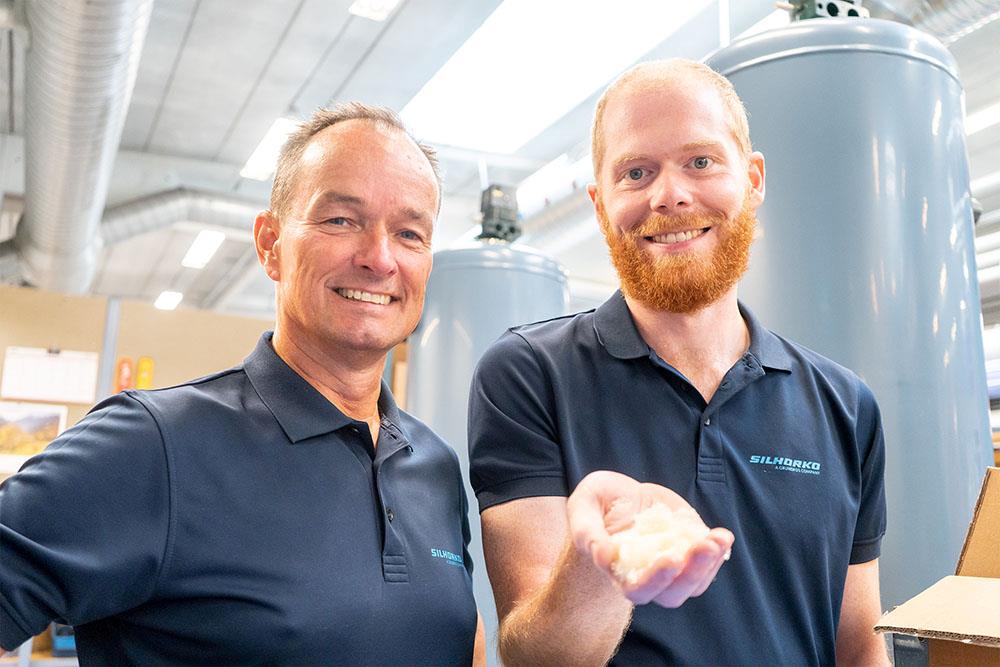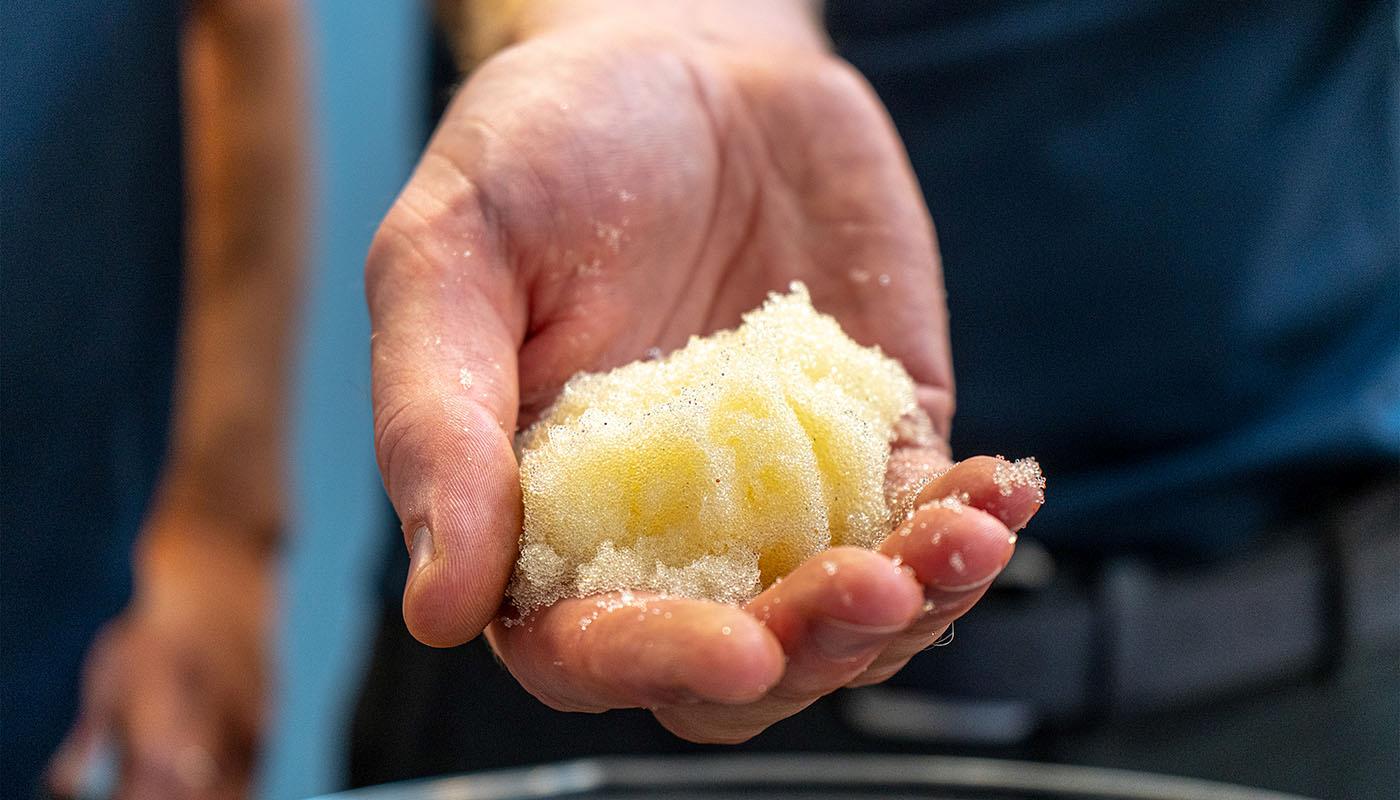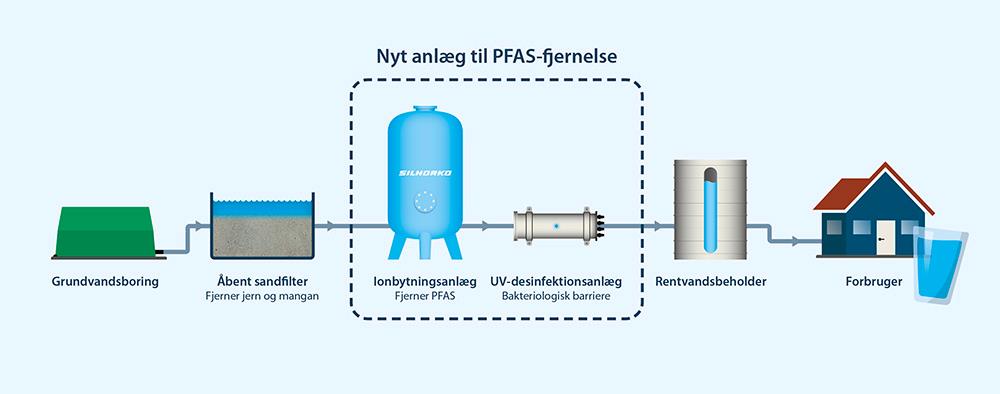Press release
PFAS-polluted drinking water on Fanø to be purified by innovative water treatment plant from EUROWATER
EUROWATER’s Head of Drinking Water, Arne Koch (left), and chemical engineer and product specialist within ion exchange technology, Søren Duch-Hennings (right), are the two key figures in the development of the innovative plant. (Photo: Christian Møller Stefffensen © Silhorko-Eurowater)

Published: September 13, 2022 | Contact
The high content of the ‘forever chemical’ PFAS in the drinking water on Fanø has caused great concern. But a solution has now been found. Using advanced ion exchange technology, EUROWATER has designed a purification method that can eliminate PFAS in drinking water, and a finished water treatment plant is expected to be put into operation on Fanø as early as the end of the year.
At the turn of the year, the limit value for the content of PFAS in drinking water was significantly lowered from 100 to two nanograms per litres. At Fanø Vand, the PFAS content is four nanograms per liters – twice the new limit value.
This lead Fanø Vand to act, and they contacted the Danish manufacturer of water treatment plants, EUROWATER, which has extensive experience with special solutions for both waterworks and industry.
“We have been under great pressure to find a solution, since it naturally is important for us to be able to comply with all declarations on the quality of our drinking water. But the solution was not immediately obvious. We couldn’t just go to a supplier who had a ready-made system that we could install - it didn’t exist,” says Kaj Svarrer, chairman of the board of Fanø Vand, and continues:
“Our working relationship with EUROWATER goes back a long way, and therefore it was quite natural for us to seek their help to solve this challenge. As a small company without an analysis or research department, we are deeply dependent on good business partners whose expertise we can draw on.”
From successful pilot test to full-scale water treatment plant
Fanø Vand and EUROWATER initiated a pilot test which quickly showed that conventional purification methods were not sufficient for the water on Fanø. Therefore, EUROWATER’s engineers designed an innovative test plant with advanced ion exchange technology.
“Normally we use ion exchange resin to remove scale or salt from the water, but one of our skilled chemical engineers saw that potentially, with the right type of ion exchange resins, we could remove PFAS instead,” says Arne Koch, Head of Drinking Water at EUROWATER.
The type of ion exchange resin that is used in the new water treatment plant to remove PFAS from the drinking water. (Photo: Christian Møller Steffensen © Silhorko-Eurowater)
The ion exchange technology proved to be the right solution, and the results told their own tale. The purification did not just lower the content of PFAS to below the limit value – it was eliminated.
Measurements of the purified water showed that the PFAS content was now so low that the measuring equipment could no longer register it. In specific terms, this means that the PFAS content for certain is below 0.1 nanograms per liters, if there is any left at all.
“The fact that we succeeded in finding an ion exchange resin type that reacted so optimally with the unwanted PFAS pollutants in the water is a great victory. We had a presumption that it would work, but we had no knowledge or experience to lean on. So, we feel that we have broken important new ground in this pilot test - both for Fanø and for other waterworks that may have to face similar challenges,” says Arne Koch.
The pilot test has been running for more than half a year, and the measurements still show a PFAS content far below the limit value. Therefore, EUROWATER is now designing and building a full-scale treatment plant based on the pilot project. The plant is expected to be put into operation on Fanø at the end of the year, and then it will be able to purify as much as 150 m3 (150,000 liters) of drinking water per hour.
“It has been important to us that we could get below the limit value, but it is nice to know that with the new plant the PFAS content in the drinking water can be lowered so much that it can no longer be measured. Of course, we must continue to follow the development of the measurements, but both we and the authorities, we have spoken to, sincerely believe that the method is the right one,” Kaj Svarrer from Fanø Vand concludes.
Until the new plant is ready, EUROWATER is setting up a temporary carbon filtration plant on Fanø, which will lower the PFAS content in the drinking water on Fanø by approximately 40 percent.

The water’s path from drilling to tap on Fanø, after the new water treatment plant from EUROWATER has been installed. After the ion exchange unit, a UV disinfection unit is added to ensure that the drinking water is also completely free of bacteria and viruses. (Illustration: Christian Møller Steffensen © Silhorko-Eurowater)

Further contact
Arne Koch, Head of Drinking Water
SILHORKO-EUROWATER A/S
tel.: (+45) 87 93 83 00, email: ako.dk@silhorko.dk
Søren Duch-Hennings, Chemical engineer and product specialist, SILHORKO-EUROWATER A/S
tel.: (+45) 86 57 12 22, email: sdu.dk@silhorko.dk
